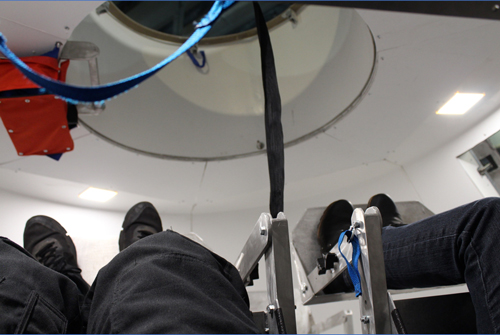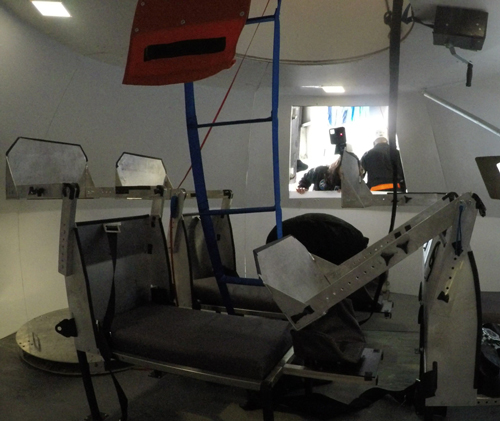Posey's Moonshot
Space Capsule Egress in Heavy Seas
What happens if a space capsule lands in an area that is experiencing big waves? Astronaut-in-training Brien walks you through the steps of escape.
One of the hazards that most people probably don't think about with regard to spaceflight is that of ocean waves. Modern space capsules such as the Orion are designed to land in the water. Although landings specifically target calmer areas of the ocean, ocean waves are always somewhat unpredictable. Additionally, there is always the possibility that an abort during a launch could result in you coming down in an unplanned area.
So what happens if a capsule lands in an area that is experiencing a high sea state (big waves)?
The best thing you can do in a situation like that is to wait it out. The capsule is airtight, so you don't have to worry about water leaking in, the capsule sinking or anything like that. I have been told, however, that if you do land in an area with a high sea state, then you can expect to become seasick.
Of course, you have to leave the safety of the capsule eventually. The capsule's batteries only last for a couple of hours after landing. Ideally, help will have arrived by that time, but I have trained for situations in which the crew is forced to evacuate the capsule in heavy seas.
The tricky thing about capsule egress during a high sea state is that you cannot safely open the side hatch. That's because if the side hatch is open, there is a good chance the waves will end up flooding the capsule. At best, this would make the egress process more difficult. At worst, it could cause the capsule to sink. That being the case, the best option is to go out the top hatch (which is usually referred to as the front hatch or the forward hatch).
It's easy to think of a space capsule as being an extremely compact and confined environment, and indeed it is. Even so, the Orion capsule is significantly larger than the Mercury, Gemini and Apollo capsules that were used in the early days of the space program. This increased size means that the ceiling is high enough that the hatch is out of reach.
In order to leave the capsule through the top hatch, we have to deploy a nylon ladder. This ladder is kept in a red box that is mounted to the capsule's ceiling. There are a couple of mount points where the ladder attaches to the floor. The ladder is designed so it can be deployed very quickly in the event of an emergency.
 [Click on image for larger view.] Figure 1: The egress ladder is stowed in the red box on the ceiling near the docking hatch.
[Click on image for larger view.] Figure 1: The egress ladder is stowed in the red box on the ceiling near the docking hatch.
With the ladder deployed, the next step is to remove the hatch. The problem with this is that the hatch weighs roughly about a hundred pounds and is fully removable. If someone were to simply pull the hatch release handle, the hatch would come crashing down to the floor, probably injuring someone in the process. To keep that from happening, we have a hatch winch system. It's a little hard to describe, but it involves attaching a nylon strap (which looks a lot like a car's seatbelt) to the hatch. Once the hatch is attached, you can safely release the hatch. You would then use a hand crank to lower the hatch to the floor.
 [Click on image for larger view.] Figure 2: The ladder has been deployed, and the hatch removed. The hatch winch is the hand crank near the ceiling, and you can see the hatch itself laying on the floor on the left side of the photo.
[Click on image for larger view.] Figure 2: The ladder has been deployed, and the hatch removed. The hatch winch is the hand crank near the ceiling, and you can see the hatch itself laying on the floor on the left side of the photo.
Once the ladder is deployed and the hatch is open, someone (usually the crew member with the most upper-body strength) has to go outside to perform two key tasks. The first of these tasks is to deploy a thermal blanket. The outside of the capsule could still be really hot from re-entry, and the thermal blanket keeps you from coming into direct contact with the hot part of the capsule.
The person who deploys the thermal blanket climbs the nylon ladder to reach the docking tunnel and then makes use of a couple of metal steps to reach the top of the hatch. Someone then hands the thermal blanket up to that person. They take the blanket and attach it to two hooks on the outside of the hatch. From there, the person lets go of the thermal blanket and it unrolls down the side of the capsule.
The second thing the person has to do is deploy the life raft. This is the more difficult of the two tasks, simply because of the raft's size and weight. The life raft weighs roughly 70 pounds and is the size of a large suitcase. Someone has to be able to hand the raft up to the person waiting at the top of the hatch. That person attaches the raft's 40-foot inflator line to a special anchor point on the capsule and then throws the raft into the water. Once the raft is in the water, the person yanks on the inflator line and the raft inflates.
Now it's time for the crew members to make their way to the raft. This is easier said than done. Remember, the capsule is rocking back and forth because of the waves and we are all wearing bulky spacesuits.
Climbing the ladder to reach the hatch isn't all that difficult. Things don't become tricky until you are out of the hatch. You have to walk along a narrow ledge at the top of the capsule and make your way to the thermal blanket. All the while, you have to avoid tripping over the capsule's righting bag cables (the righting bags are the big orange balloons in the next figure) while also keeping your balance atop a moving capsule. This would be tricky in even the best of circumstances, but the spacesuits make the process far more cumbersome.
Once you reach the thermal blanket, you have to attach a line to a repelling harness that you are wearing over your spacesuit. Once attached, you literally rappel down the side of the capsule and into the water, being careful not to touch anything other than the thermal blanket on the way down. At that point, you clamp yourself onto the raft's inflator line and release the rope that is threaded through your rappelling harness. Being clamped to the inflator line ensures the waves do not take you away from the raft and the capsule.
 [Click on image for larger view.] Figure 3: I am rappelling down the side of the capsule on the orange thermal blanket.
[Click on image for larger view.] Figure 3: I am rappelling down the side of the capsule on the orange thermal blanket.
After everyone is safely out of the capsule and in the water, the crew members help one another to get into the raft. Climbing into a raft while wearing a spacesuit is a difficult process, but it is far easier if the crew members are able to help one another.
Keep in mind that my goal for this column was to illustrate the basic procedure for a top hatch egress. In reality the procedure is a bit more involved than what I have described. There are a number of additional steps related to preparing the spacesuits for water ingress, attaching survival packs and that sort of thing. The funny thing is that when I was told that I was going to learn spacecraft egress procedures, I wondered what the big deal was. I assumed that when you are back on Earth, you just get out of the capsule. I had no idea that egress was so complex or such an adrenaline rush.
About the Author
Brien Posey is a 22-time Microsoft MVP with decades of IT experience. As a freelance writer, Posey has written thousands of articles and contributed to several dozen books on a wide variety of IT topics. Prior to going freelance, Posey was a CIO for a national chain of hospitals and health care facilities. He has also served as a network administrator for some of the country's largest insurance companies and for the Department of Defense at Fort Knox. In addition to his continued work in IT, Posey has spent the last several years actively training as a commercial scientist-astronaut candidate in preparation to fly on a mission to study polar mesospheric clouds from space. You can follow his spaceflight training on his Web site.